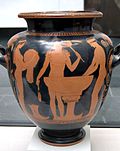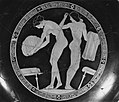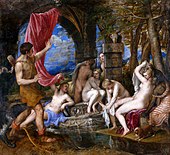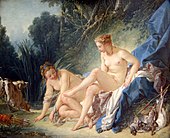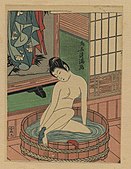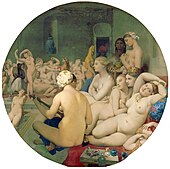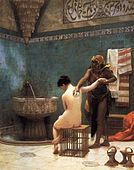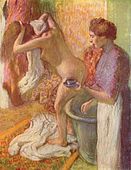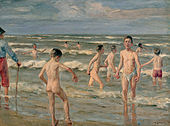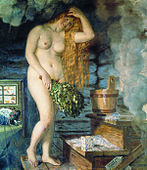Bathing

Bathing is the washing of the body with a liquid, usually water or an aqueous solution, or the immersion of the body in water. It may be practiced for personal hygiene, religious ritual or therapeutic purposes. By analogy, especially as a recreational activity, the term is also applied to sun bathing and sea bathing.
Bathing can take place in any situation where there is water, ranging from warm to cold. It can take place in a bathtub or shower, or it can be in a river, lake, water hole, pool, or the sea, or any other water receptacle. The term for the act can vary. For example, a ritual religious bath is sometimes referred to as immersion or baptism, the use of water for therapeutic purposes can be called a water treatment or hydrotherapy, and two recreational water activities are known as swimming and paddling.
History
Ancient world
Throughout history, societies devised systems to enable water to be brought to population centers.
The oldest accountable daily ritual of bathing can be traced to the ancient Indians. They used elaborate practices for personal hygiene with three daily baths and washing. These are recorded in the works called grihya sutras and are in practice today in some communities.
Ancient Greece utilized small bathtubs, wash basins, and foot baths for personal cleanliness. The earliest findings of baths date from the mid-2nd millennium BC in the palace complex at Knossos, Crete, and the luxurious alabaster bathtubs excavated in Akrotiri, Santorini. A word for bathtub, asaminthos (ἀσάμινθος), occurs eleven times in Homer. As a legitimate Mycenaean word (a-sa-mi-to) for a kind of vessel that could be found in any Mycenaean palace, this Linear B term derives from an Aegean suffix -inth- being appended to an Akkadian loan word with the root namsû ("washbowl, washing tub"). This luxurious item of the Mycenaean palace culture, therefore, was clearly borrowed from the Near East.[1] Later Greeks established public baths and showers within gymnasiums for relaxation and personal hygiene. The word gymnasium (γυμνάσιον) comes from the Greek word gymnos (γυμνός), meaning "naked."
Ancient Rome developed a network of aqueducts to supply water to all large towns and population centers and had indoor plumbing, with pipes that terminated in homes and at public wells and fountains. The Roman public baths were called thermae. The thermae were not simply baths, but important public works that provided facilities for many kinds of physical exercise and ablutions, with cold, warm, and hot baths, rooms for instruction and debate, and usually one Greek and one Latin library. They were provided for the public by a benefactor, usually the Emperor. Other empires of the time didn't show such an affinity for public works, but this Roman practice spread their culture to places where there may have been more resistance to foreign mores. Unusually for the time, the thermae was not class-stratified, being available to all for no charge or a small fee. With the fall of the Roman Empire, the aqueduct system fell into disrepair and disuse. But even before that, during the Christianization of the Empire, changing ideas about public morals led the baths into disfavor.
Medieval Japan
Before the 7th century, the Japanese were likely to have bathed in the many springs in the open, as there is no evidence of closed rooms. In the 6th to 8th centuries (in the Asuka and Nara periods) the Japanese absorbed the religion of Buddhism from China, which had a strong impact on the culture of the entire country. Buddhist temples traditionally included a bathhouse (yuya) for the monks. Due to the principle of purity espoused by Buddhism these baths were eventually opened to the public. Only the wealthy had private baths.
The first public bathhouse was mentioned in 1266. In Edo (modern Tokyo), the first sentō was established in 1591. The early steam baths were called iwaburo (岩風呂 "rock pools") or kamaburo (釜風呂 "furnace baths"). These were built into natural caves or stone vaults. In iwaburo along the coast, the rocks were heated by burning wood, then sea water was poured over the rocks, producing steam. The entrances to these "bath houses" were very small, possibly to slow the escape of the heat and steam. There were no windows, so it was very dark inside and the user constantly coughed or cleared their throats in order to signal to new entrants which seats were already occupied. The darkness could be also used to cover sexual contact. Because there was no gender distinction, these baths came into disrepute. They were finally abolished in 1870 on hygienic and moral grounds. Author John Gallagher says bathing "was segregated in the 1870s as a concession to outraged Western tourists".[2]
At the beginning of the Edo period (1603–1868) there were two different types of baths. In Edo, hot-water baths ('湯屋 yuya) were common, while in Osaka, steam baths (蒸風呂 mushiburo) were common. At that time shared bathrooms for men and women were the rule. These bathhouses were very popular, especially for men. "Bathing girls" (湯女 yuna) were employed to scrub the guests' backs and wash their hair, etc. In 1841, the employment of yuna was generally prohibited, as well as mixed bathing. The segregation of the sexes, however, was often ignored by operators of bathhouses, or areas for men and women were separated only by a symbolic line. Today, sento baths have separate rooms for men and women.[3]
Mesoamerica
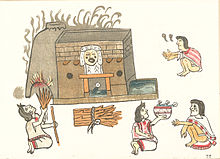
Spanish chronicles describe the bathing habits of the peoples of Mesoamerica during and after the conquest. Bernal Díaz del Castillo describes Moctezuma (the Mexica, or Aztec, king at the arrival of Cortés) in his Historia verdadera de la conquista de la Nueva España as being "...Very neat and cleanly, bathing every day each afternoon...". Bathing was not restricted to the elite, but was practised by all people; the chronicler Tomás López Medel wrote after a journey to Central America that "Bathing and the custom of washing oneself is so quotidian (common) amongst the Indians, both of cold and hot lands, as is eating, and this is done in fountains and rivers and other water to which they have access, without anything other than pure water..."[4]
The Mesoamerican bath, known as temazcal in Spanish, from the Nahuatl word temazcalli, a compound of temaz ("steam") and calli ("house"), consists of a room, often in the form of a small dome, with an exterior firebox known as texictle (teʃict͜ɬe) that heats a small portion of the room's wall made of volcanic rocks; after this wall has been heated, water is poured on it to produce steam, an action known as tlasas. As the steam accumulates in the upper part of the room a person in charge uses a bough to direct the steam to the bathers who are lying on the ground, with which he later gives them a massage, then the bathers scrub themselves with a small flat river stone and finally the person in charge introduces buckets with water with soap and grass used to rinse. This bath had also ritual importance, and was vinculated to the goddess Toci; it is also therapeutic when medicinal herbs are used in the water for the tlasas. It is still used in Mexico.[4][5]
Medieval and early-modern Europe

Christianity has always placed a strong emphasis on hygiene.[6] Despite the denunciation of the mixed bathing style of Roman pools by early Christian clergy, as well as the pagan custom of women bathing naked in front of men, this did not stop the Church from urging its followers to go to public baths for bathing,[7] which contributed to hygiene and good health according to the Church Fathers, Clement of Alexandria and Tertullian. The Church also built public bathing facilities that were separate for both sexes near monasteries and pilgrimage sites; also, the popes situated baths within church basilicas and monasteries since the early Middle Ages.[8] Pope Gregory the Great urged his followers on value of bathing as a bodily need.[9]
Great bathhouses were built in Byzantine centers such as Constantinople and Antioch,[10] and the popes allocated to the Romans bathing through diaconia, or private Lateran baths, or even a myriad of monastic bath houses functioning in eighth and ninth centuries.[9] The Popes maintained their baths in their residences which described by scholar Paolo Squatriti as " luxurious baths", and bath houses including hot baths incorporated into Christian Church buildings or those of monasteries, which known as "charity baths" because they served both the clerics and needy poor people.[11] Public bathing were common in medivail Christendom larger towns and cities such as Paris, Regensburg and Naples.[12][13] Catholic religious orders of the Augustinians' and Benedictines' rules contained ritual purification,[14] and inspired by Benedict of Nursia encouragement for the practice of therapeutic bathing; Benedictine monks played a role in the development and promotion of spas.[15] Protestantism also played a prominent role in the development of the British spas.[15]
In the Middle Ages, bathing commonly took place in public bathhouses. Public baths were also havens for prostitution, which created some opposition to them. Rich people bathed at home, most likely in their bedroom, as 'bath' rooms were not common. Bathing was done in large, wooden tubs with a linen cloth laid in it to protect the bather from splinters. Additionally, during the Renaissance and Protestant Reformation, the quality and condition of the clothing (as opposed to the actual cleanliness of the body itself) were thought to reflect the soul of an individual. Clean clothing also reflected one's social status; clothes made the man or woman.
Furthermore, from the late Middle Ages through to the end of the 18th century, etiquette and medical manuals advised people to only wash the parts of the body that were visible to the public; for example, the ears, hands, feet, and face and neck. This did away with the public baths and left the cleaning of oneself to the privacy of one's home.[citation needed]
The switch from woolen to linen clothing by the 16th century also accompanied the decline in bathing. Linen clothing is much easier to clean and maintain – and such clothing was becoming commonplace at the time in Western Europe. Clean linen shirts or blouses allowed people who had not bathed to appear clean and well groomed. The possession of a large quantity of clean linen clothing was a sign of social status. Thus, appearance became more important than personal hygiene. Contemporary medical opinion also supported this claim. Physicians of the period believed that odors, or miasma, such as that which would be found in soiled linens, caused disease. A person could therefore change one's shirt every few days, but avoid baths – which might let the "bad air" into the body through the pores. Consequently, in an age in which there were very few personal bathtubs, laundry was an important and weekly chore which was commonly undertaken by laundresses of the time.[citation needed]
Modern era
Therapeutic bathing
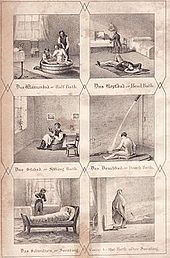
Public opinion about bathing began to shift in the middle and late 18th century, when writers argued that frequent bathing might lead to better health. Two English works on the medical uses of water were published in the 18th century that inaugurated the new fashion for therapeutic bathing. One of these was by Sir John Floyer, a physician of Lichfield, who, struck by the remedial use of certain springs by the neighbouring peasantry, investigated the history of cold bathing and published a book on the subject in 1702. [16] The book ran through six editions within a few years and the translation of this book into German was largely drawn upon by Dr J. S. Hahn of Silesia as the basis for his book called On the Healing Virtues of Cold Water, Inwardly and Outwardly Applied, as Proved by Experience, published in 1738.[17]
The other work was a 1797 publication by Dr James Currie of Liverpool on the use of hot and cold water in the treatment of fever and other illness, with a fourth edition published not long before his death in 1805.[18] It was also translated into German by Michaelis (1801) and Hegewisch (1807). It was highly popular and first placed the subject on a scientific basis. Hahn's writings had meanwhile created much enthusiasm among his countrymen, societies having been everywhere formed to promote the medicinal and dietetic use of water; in 1804 Professor E.F.C. Oertel of Anspach republished them and quickened the popular movement by the unqualified commendation of water drinking as a remedy for all diseases. [19]
A popular revival followed the application of hydrotherapy around 1829, by Vincenz Priessnitz, a peasant farmer in Gräfenberg, then part of the Austrian Empire.[20] [21] This revival was continued by a Bavarian priest, Sebastian Kneipp (1821–1897), "an able and enthusiastic follower" of Priessnitz, "whose work he took up where Priessnitz left it", after he read a treatise on the cold water cure.[22] In Wörishofen (south Germany), Kneipp developed the systematic and controlled application of hydrotherapy for the support of medical treatment that was delivered only by doctors at that time. Kneipp's own book My Water Cure was published in 1886 with many subsequent editions, and translated into many languages.
Captain R. T. Claridge was responsible for introducing and promoting hydropathy in Britain, first in London in 1842, then with lecture tours in Ireland and Scotland in 1843. His 10-week tour in Ireland included Limerick, Cork, Wexford, Dublin and Belfast,[23] over June, July and August 1843, with two subsequent lectures in Glasgow.[24]
Public baths
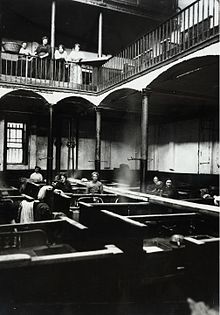
Large public baths such as those found in the ancient world and the Ottoman Empire were revived during the 19th century. The first modern public baths were opened in Liverpool in 1829. The first known warm fresh-water public wash house was opened in May 1842.[11]: 2–14 [25]
The popularity of wash-houses was spurred by the newspaper interest in Kitty Wilkinson, an Irish immigrant "wife of a labourer" who became known as the Saint of the Slums.[26] In 1832, during a cholera epidemic, Wilkinson took the initiative to offer the use of her house and yard to neighbours to wash their clothes, at a charge of a penny per week,[11] and showed them how to use a chloride of lime (bleach) to get them clean. She was supported by the District Provident Society and William Rathbone. In 1842 Wilkinson was appointed baths superintendent.[27][28]
In Birmingham, around ten private baths were available in the 1830s. Whilst the dimensions of the baths were small, they provided a range of services.[29] A major proprietor of bath houses in Birmingham was a Mr. Monro who had had premises in Lady Well and Snow Hill.[30] Private baths were advertised as having healing qualities and being able to cure people of diabetes, gout and all skin diseases, amongst others.[30] On 19 November 1844, it was decided that the working class members of society should have the opportunity to access baths, in an attempt to address the health problems of the public. On 22 April and 23 April 1845, two lectures were delivered in the town hall urging the provision of public baths in Birmingham and other towns and cities.
After a period of campaigning by many committees, the Public Baths and Wash-houses Act received royal assent on 26 August 1846. The Act empowered local authorities across the country to incur expenditure in constructing public swimming baths out of its own funds.[31]
The first London public baths was opened at Goulston Square, Whitechapel, in 1847 with the Prince consort laying the foundation stone.[32][33]
Hot public baths

"Turkish" baths (based on the traditional Muslim bathhouses which are derived from the Roman bath) were introduced to Britain by David Urquhart, diplomat and sometime Member of Parliament for Stafford, who for political and personal reasons wished to popularize Turkish culture. In 1850 he wrote The Pillars of Hercules, a book about his travels in 1848 through Spain and Morocco. He described the system of dry hot-air baths used there and in the Ottoman Empire which had changed little since Roman times. In 1856 Richard Barter read Urquhart's book and worked with him to construct a bath. They opened the first modern hot water bath at St Ann's Hydropathic Establishment near Blarney, County Cork, Ireland.[34]
The following year, the first public bath of its type to be built in mainland Britain since Roman times was opened in Manchester, and the idea spread rapidly. It reached London in July 1860, when Roger Evans, a member of one of Urquhart's Foreign Affairs Committees, opened a Turkish bath at 5 Bell Street, near Marble Arch. During the following 150 years, over 600 Turkish baths opened in Britain, including those built by municipal authorities as part of swimming pool complexes, taking advantage of the fact that water-heating boilers were already on site.
Similar baths opened in other parts of the British Empire. Dr. John Le Gay Brereton opened a Turkish bath in Sydney, Australia in 1859, Canada had one by 1869, and the first in New Zealand was opened in 1874. Urquhart's influence was also felt outside the Empire when in 1861, Dr Charles H Shepard opened the first Turkish baths in the United States at 63 Columbia Street, Brooklyn Heights, New York, most probably on 3 October 1863.[35][36]
Soap promoted for personal cleanliness

By the mid-19th century, the English urbanised middle classes had formed an ideology of cleanliness that ranked alongside typical Victorian concepts, such as Christianity, respectability and social progress.[37] The cleanliness of the individual became associated with his or her moral and social standing within the community and domestic life became increasingly regulated by concerns regarding the presentation of domestic sobriety and cleanliness. [38]
The industry of soapmaking began on a small scale in the 1780s, with the establishment of a soap manufactory at Tipton by James Keir and the marketing of high-quality, transparent soap in 1789 by Andrew Pears of London. It was in the mid-19th century, though, that the large-scale consumption of soap by the middle classes, anxious to prove their social standing, drove forward the mass production and marketing of soap.
William Gossage produced low-priced, good-quality soap from the 1850s. William Hesketh Lever and his brother, James, bought a small soap works in Warrington in 1886 and founded what is still one of the largest soap businesses, formerly called Lever Brothers and now called Unilever. These soap businesses were among the first to employ large-scale advertising campaigns.
Before the late 19th century, water to individual places of residence was rare.[39] Many countries in Europe developed a water collection and distribution network. London water supply infrastructure developed through major 19th-century treatment works built in response to cholera threats, to modern large-scale reservoirs. By the end of the century, private baths with running hot water were increasingly common in affluent homes in America and Britain.
At the beginning of the 20th century, a weekly Saturday night bath had become common custom for most of the population. A half day's work on Saturday for factory workers allowed them some leisure to prepare for the Sunday day of rest. The half day off allowed time for the considerable labor of drawing, carrying, and heating water, filling the bath and then afterward emptying it. To economize, bath water was shared by all family members. Indoor plumbing became more common in the 20th century and commercial advertising campaigns pushing new bath products began to influence public ideas about cleanliness, promoting the idea of a daily shower or bath.[citation needed]
In the twenty-first century challenges to the need for soap to effect such everyday cleanliness and whether soap is needed to avoid body odor, appeared in media.[40]
Purpose
One purpose of bathing is for personal hygiene. It is a means of achieving cleanliness by washing away dead skin cells, dirt, and soil and as a preventative measure to reduce the incidence and spread of disease. It also may reduce body odors, however, some people note that may not be so necessary as commonly thought.[40]
Bathing creates a feeling of well-being and the physical appearance of cleanliness.
Bathing may also be practised for religious ritual or therapeutic purposes[41] or as a recreational activity. Bathing may be used to cool or to warm the body of an individual.
Therapeutic use of bathing includes hydrotherapy, healing, rehabilitation from injury or addiction, and relaxation.
The use of a bath in religious ritual or ceremonial rites include immersion during baptism in Christianity and to achieve a state of ritual cleanliness in a mikvah in Judaism. It is referred to as Ghusl in Arabic to attain ceremonial purity (Taahir) in Islam. All major religions place an emphasis on ceremonial purity, and bathing is one of the primary means of attaining outward purity. In Hindu households, any acts of defilement are countered by undergoing a bath and Hindus also immerse in Sarovar as part of religious rites. In the Sikh religion, there is a place at Golden Temple where the leprosy of Rajni's husband was cured by immersion into the holy sacred pool, and many pilgrims bathe in the sacred pool believing it will cure their illness as well.
Types of baths

Where bathing is for personal hygiene, bathing in a bathtub or shower is the most common form of bathing in Western, and many Eastern, countries. Bathrooms usually have a tap, and a shower if it is a modern home, and a huge water heating pot. People take water from the tap or the water-heating pot into a large bucket and use a mug to pour water on themselves. A soap and loofah is used to clean the body after, and then rinsed again using the mug. People most commonly bath in their home or use a private bath in a public bathhouse. In some societies, bathing can take place in rivers, creeks, lakes or water holes, or any other place where there is an adequate pool of water. The quality of water used for bathing purposes varies considerably. Normally bathing involves use of soap or a soap-like substance, such as shower gel. In southern India people more commonly use aromatic oil and other home-made body scrubs.
Bathing occasions can also be occasions of social interactions, such as in public, Turkish, banya, sauna or whirlpool baths.
Sponge bath
When water is in short supply or a person is not fit to have a standing bath, a wet cloth or sponge can be used, or the person can wash by splashing water over their body. A sponge bath is usually conducted in hospitals, which involves one person washing another with a sponge, while the person being washed remains lying in bed.
Ladling water from a container

This method involves using a small container to scoop water out of a large container and pour water over the body, in such a way that this water does not go back into the large container.
In Indonesia and Malaysia, this is a traditional method referred to as mandi.
In the Indonesian language, mandi is the verb for this process; bak mandi is the large container, and kamar mandi is the place in which this is done.[42][43] Travel guides[44][45][46] often use the word mandi on its own or in various ways such as for the large container and for the process of bathing.
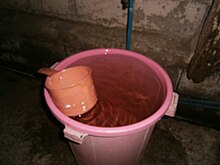
In the Philippines, timba (pail) and tabo (dipper) are two essentials in every bathroom.
Clothing
When bathing for cleanliness, normally, people bathe completely naked, so as to make cleaning every part of their body possible. This is the case in private baths, whether in one's home or a private bath in a public bathhouse. In public bathing situations, the social norms of the community are followed, and some people wear a swimsuit or underwear. For example, when a shower is provided in a non-sex segregated area of a public swimming pool, users of the shower commonly wear their swimsuit. The customs can vary depending on the age of a person, and whether the bathing is in a sex segregated situation. In some societies, some communal bathing is also done without clothing.
When swimming, not wearing clothing is sometimes called skinny dipping.
Bathing babies
Babies can be washed in a kitchen sink or a small plastic baby bath, instead of using a standard bath which offers little control of the infant's movements and requires the parent to lean awkwardly or kneel.[47] Bathing infants too often has been linked to the development of asthma or severe eczema according to some researchers, including Michael Welch, chair of the American Academy of Pediatrics' section on allergy and immunology.[48] A safe temperature for the bathwater is generally held to be 32–38 °C (90–100 °F).[49]
Japanese bathing culture
Private baths

Today, most homes in Japan have a bathroom (ofuro), which was often not the case about 30 years ago. Bath water in Japan is much hotter than what is usual in Central Europe. The temperature is usually well above 40 °C. In medical literature, 47 °C is considered bearable.[50] The heat is considered a prerequisite for complete relaxation. The custom is to thoroughly clean oneself with soap and rinse before entering the tub, so as not to contaminate the bath water. Until the 19th century, the Japanese did not use soap, but rubbed the skin with certain herbs, or rice bran, which was also a natural exfoliant.
Public baths

In public baths, there is a distinction between those with natural hot springs called, onsen (hot), and the other, the sento. Since Japan is located in a volcanically active region, there are many hot springs, of which about 2000 are swimming pools. Most onsen are in the open countryside, but they are also found in cities. In Tokyo, for example, there are about 25 onsen baths. Locations of known mineral springs spas are on the Western model.
An onsen, consists mostly of outdoor pools (rotenburo), which are sometimes at different temperatures. Extremely hot springs, where even experienced or frequent hot-spring bathers can only stay a few minutes, are called jigoku (hell). Many onsen also have saunas, spa treatments and therapy centers. The same rules apply in public baths as in private baths, with bathers required to wash and clean themselves before entering the water. In general, the Japanese bathe naked in bathhouses; bathing suits are not permissible.
Art motif
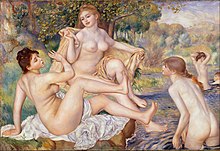

Bathing scenes were already in the Middle Ages a popular subject of painters. Most of the subjects were women shown nude, but the interest was probably less to the bathing itself rather than to provide the context for representing the nude figure. From the Middle Ages, illustrated books of the time contained such bathing scenes. Biblical and mythological themes which featured bathing were depicted by numerous painters. Especially popular themes included Bathsheba in the bath, in which she is observed by King David, and Susanna in the sight of lecherous old men.
In the High Middle Ages, public baths were a popular subject of painting, with rather clear depictions of sexual advances, which probably were not based on actual observations. During the Renaissance and Baroque periods, the gods and nymphs of Greek mythology were depicted bathing in allegorical paintings by artists such as Titian and François Boucher, both of whom painted the goddess Diana bathing. Artists continued to paint Biblical characters bathing, and also sometimes depicted contemporary women bathing in the river, an example being Rembrandt's Woman Bathing.
In the 19th century, the use of the bathing scene reached its high point in classicism, realism and impressionism. Oriental themes and harem and turkish baths scenes became popular. These scenes were based on the artists' imagination, because access by men to Islamic women was not generally permitted.[52] In the second half of the century, artists increasingly eschewed the pretexts of mythology and exoticism, and painted contemporary western women bathing. Edgar Degas, for example, painted over 100 paintings with a bathing theme. The subject of Bathers remained popular in avant-garde circles at the outset of the 20th century.
Notable artists who have represented bathing scenes:
- Lawrence Alma-Tadema
- Pierre Bonnard
- William-Adolphe Bouguereau
- François Boucher
- Paul Cézanne
- Gustave Courbet
- Lucas Cranach the Younger
- Edgar Degas
- Albrecht Dürer
- Anthony van Dyck
- Roger de La Fresnaye
- Paul Gauguin
- Jean-Léon Gérôme
- Albert Gleizes
- Jean-Auguste-Dominique Ingres
- Ernst Ludwig Kirchner
- Boris Kustodiev
- Max Liebermann
- Édouard Manet
- Jean Metzinger
- Pablo Picasso
- Pierre-Auguste Renoir
- Sebastiano Ricci
- Zinaida Serebriakova
- Joaquín Sorolla y Bastida
- Domenico Tintoretto
- Titian
- Anders Zorn
-
Lucas Cranach, The Golden Age, 1530
-
Titian, Actaeon Surprises Diana in Her Bath, 1559
-
Wolfgang Heimbach, People Bathing, 1640
-
François Boucher, Diana Leaving Her Bath, 1742
-
Torii Kiyomitsu, Bathing Woman, 1750
-
Jean-Léon Gérôme, The Bath, ca. 1880
-
Edgar Degas, After the Bath, ca. 1890
-
Paul Gauguin, By the Sea, 1892
-
Paul Cézanne, The Large Bathers (detail)
-
Lawrence Alma-Tadema, The Baths at Caracalla, 1899
-
Max Liebermann, Bathing Boys, 1900
-
Joaquín Sorolla y Bastida, Sad Inheritance, 1900. Crippled children bathing at the sea in Valencia
-
Anders Zorn, Girls from Dalarna Having a Bath, 1906
-
Zinaida Serebriakova, Banya, 1913
-
Ernst Ludwig Kirchner, The Soldier Bath, 1915
-
Boris Kustodiev, Russian Venus, 1926
-
Pablo Picasso, Quatre baigneuses (Four Bathers), 1922, Collection Paul Allen
See also
References
- ^ Reece, Steve, "The Homeric Ἀσάμινθος: Stirring the Waters of the Mycenaean Bath," Mnemosyne: A Journal of Classical Studies 55.6 (2002) 703-708. The Homeric Asaminthos
- ^ Gallagher, J. (2003). Geisha: A Unique World of Tradition, Elegance, and Art. London: PRC Pub. p. 87. ISBN 1856486974
- ^ Badehäuser, Schwitzbäder, Heisse Quellen. Katalog der Staatlichen Museen zu Berlin, Berlin 1997.
- ^ a b Hernández, J. C. (n.d.). www.izt.uam.mx. Retrieved December 18, 2012, from "Archived copy" (PDF). Archived from the original (PDF) on 2013-04-06. Retrieved 2012-12-18.
{{cite web}}: CS1 maint: archived copy as title (link) - ^ Temazcal. (2012, 25 de agosto). Wikipedia, La enciclopedia libre. Fecha de consulta: 08:24, diciembre 18, 2012 desde http://es.wikipedia.org/w/index.php?title=Temazcal&oldid=59102538.
- ^ Warsh, Cheryl Krasnick (2006). Children's Health Issues in Historical Perspective. Veronica Strong-Boag. Wilfrid Laurier Univ. Press. p. 315. ISBN 9780889209121.
... From Fleming's perspective, the transition to Christianity required a good dose of personal and public hygiene ...
- ^ Warsh, Cheryl Krasnick (2006). Children's Health Issues in Historical Perspective. Veronica Strong-Boag. Wilfrid Laurier Univ. Press. p. 315. ISBN 9780889209121.
... Thus bathing also was considered a part of good health practice. For example, Tertullian attended the baths and believed them hygienic. Clement of Alexandria, while condemning excesses, had given guidelines for Christians who wished to attend the baths ...
- ^ Thurlkill, Mary (2016). Sacred Scents in Early Christianity and Islam: Studies in Body and Religion. Rowman & Littlefield. pp. 6–11. ISBN 978-0739174531.
... Clement of Alexandria (d. c. 215 CE) allowed that bathing contributed to good health and hygiene ... Christian skeptics could not easily dissuade the baths' practical popularity, however; popes continued to build baths situated within church basilicas and monasteries throughout the early medieval period ...
- ^ a b Squatriti, Paolo (2002). Water and Society in Early Medieval Italy, AD 400-1000, Parti 400-1000. Cambridge University Press. p. 54. ISBN 9780521522069.
... but baths were normally considered therapeutic until the days of Gregory the Great, who understood virtuous bathing to be bathing "on account of the needs of body" ...
- ^ Kazhdan, Alexander, ed. (1991), Oxford Dictionary of Byzantium, Oxford University Press, ISBN 978-0-19-504652-6
- ^ a b c Ashpitel, Arthur (1851), Observations on baths and wash-houses, JSTOR 60239734, OCLC 501833155
- ^ Black, Winston (2019). The Middle Ages: Facts and Fictions. ABC-CLIO. p. 61. ISBN 9781440862328.
Public baths were common in the larger towns and cities of Europe by the twelfth century.
- ^ Kleinschmidt, Harald (2005). Perception and Action in Medieval Europe. Boydell & Brewer. p. 61. ISBN 9781843831464.
The evidence of early medieval laws that enforced punishments for the destruction of bathing houses suggests that such buildings were not rare. That they ... took a bath every week. At places in southern Europe, Roman baths remained in use or were even restored ... The Paris city scribe Nicolas Boileau noted the existence of twenty-six public baths in Paris in 1272
- ^ Hembry, Phyllis (1990). The English Spa, 1560-1815: A Social History. Fairleigh Dickinson Univ Press. ISBN 9780838633915.
- ^ a b Bradley, Ian (2012). Water: A Spiritual History. Bloomsbury Publishing. ISBN 9781441167675.
- ^ John Floyer & Edward Batnard (1715) [1702]. Psychrolousia. Or, the History of Cold Bathing: Both Ancient and Modern. In Two Parts. The First, written by Sir John Floyer, of Litchfield. The Second, treating the genuine life of Hot and Cold Baths..(exceedingly long subtitles) by Dr. Edward Batnard. London: William Innys. Fourth Edition, with Appendix. Retrieved 2009-10-22. Full text at Internet Archive (archive.org)
- ^ Hahn, J.S. (1738). On the Power and Effect of Cold Water. Cited in Richard Metcalfe (1898), pp.5–6. Per Encyclopædia Britannica, this was also titled On the Healing Virtues of Cold Water, Inwardly and Outwardly applied, as proved by Experience
- ^ Currie, James (1805). "Medical Reports, on the Effects of Water, Cold and Warm, as a remedy in Fever and Other Diseases, Whether applied to the Surface of the Body or used Internally". Including an Inquiry into the Circumstances that render Cold Drink, or the Cold Bath, Dangerous in Health, to which are added; Observations on the Nature of Fever; and on the effects of Opium, Alcohol, and Inanition. Vol. Vol.1 (4th, Corrected and Enlarged ed.). London: T. Cadell and W. Davies. Retrieved 2 December 2009.
{{cite book}}:|volume=has extra text (help) Full text at Internet Archive (archive.org) - ^ Claridge, Capt. R.T. (1843, 8th ed), pp.14 49, 54, 57, 68, 322, 335. Note: Pagination in online field does not match book pagination. Type "Oertel" into search field to find citations.
- ^ Claridge, Capt. R.T. (1843). Hydropathy; or The Cold Water Cure, as practiced by Vincent Priessnitz, at Graefenberg, Silesia, Austria (8th ed.). London: James Madden and Co. Retrieved 2009-10-29. Full text at Internet Archive (archive.org). Note: The "Advertisement", pp.v-xi, appears from the 5th ed onwards, so references to time pertain to time as at 5th edition.
- ^ Bradley, James (2003). Cold cure: Hydrotherapy had exotic origins, but became a firm favourite of the Victorian elite. Wellcome Trust: News and Features. Archived from the original on 11 October 2010. Retrieved 17 November 2009.
- ^ Kneipp, Sebastian (1891). My Water Cure, As Tested Through More than Thirty Years, and Described for the Healing of Diseases and the Preservation of Health. Edinburgh & London: William Blackwood & Sons. Retrieved 3 December 2009. translation from the 30th German edition. Full text at Internet Archive (archive.org).
- ^ Beirne, Peter. The Ennis Turkish Baths 1869–1878. County Cork Library. p. see note 11. Retrieved 30 October 2009. Originally published in The Other Clare vol. 32 (2008) pp 12-17
- ^ Anon. (1843). Hydropathy, or the Cold Water Cure. The Substance of Two Lectures, delivered by Captain Claridge, F.S.A., at the Queens Concert Rooms, Glasgow. Retrieved 12 June 2010.
- ^ Metcalfe, Richard (1877), Sanitas Sanitatum et Omnia Sanitas, vol. 1, Co-operative printing company, p. 3
- ^ "'Slum Saint' honoured with statue". BBC News. 4 February 2010.
- ^ Wohl, Anthony S. (1984), Endangered lives: public health in Victorian Britain, Taylor & Francis, p. 73, ISBN 978-0-416-37950-1
- ^ Rathbone, Herbert R. (1927), Memoir of Kitty Wilkinson of Liverpool, 1786-1860: with a short account of Thomas Wilkinson, her husband, H. Young & Sons
- ^ Topography of Warwickshire, William West, 1830
- ^ a b The Birmingham Journal: Private Bath Advertisements, 17 May 1851
- ^ "Baths and Wash-Houses". The Times. 22 July 1846. p. 6.
Yesterday the bill, as amended by the committee, for promoting the voluntary establishment in boroughs and parishes in England and Wales of public baths and wash-houses was printed.
- ^ "Classified Advertising". The Times. 26 July 1847. p. 1.
Model Public Baths, Goulston-square, Whitechapel. The BATHS for men and boys are now OPEN from 5 in the morning till 10 at night. Charges - first-class (two towels), cold bath 5d., warm bath 6d.; second-class (one towel), cold bath 1d, warm bath 2d. Every bath is in a private room.
- ^ Metcalfe, Richard (1877), Sanitas Sanitatum et Omnia Sanitas, vol. 1, Co-operative printing company, p. 7
- ^ Shifrin, Malcolm (3 October 2008), "St Ann's Hydropathic Establishment, Blarney, Co. Cork", Victorian Turkish Baths: Their origin, development, and gradual decline, retrieved 12 December 2009
- ^ The Brooklyn Daily Eagle, 3 October 1863
- ^ Institute, Philadelphia Natatorium Physical (1860). To Philadelphians on behalf of the Natatorium & Physical Institute. p. 11. Retrieved 4 December 2012.
- ^ Eveleigh, Bogs (2002). Baths and Basins: The Story of Domestic Sanitation. Stroud, England: Sutton.
- ^ "Health & Hygiene in Nineteenth Century England". Retrieved 23 May 2019.
- ^ The Western Heritage (2004) by Donald Kagan, Steven E Ozment, and Frank M Turner. ISBN 0-13-182839-8
- ^ a b Fleming, Amy, ‘I don’t smell!’ Meet the people who have stopped washing, The Guardian, August 5, 2019
- ^ Shove, Elizabeth (2004). Comfort, Cleanliness and Convenience The Social Organization of Normality (New Technologies/New Cultures). New York: Berg. ISBN 978-1-85973-630-2.
- ^ From the Kamus Besar Bahasa Indonesia, fourth edition:
mandi v. to wash one's body with water and soap (by pouring water over or soaking one's body, etc.) [membersihkan tubuh dng air dan sabun dng cara menyiramkan, merendamkan diri ke air, dsb.] p.871
bak mandi n. something used to hold water for bathing [kolam tempat air untuk mandi], p. 121
kamar mandi n. place for bathing [bilik tempat mandi], p. 611
- ^ http://en.allexperts.com/q/Indonesia-193/Indonesian-culture.htm Accessed: 2011-03-08. (Archived by WebCite® at https://www.webcitation.org/5x2cjVbxL)[dead link]
- ^ Lonely Planet website - Indonesia: “Cheaper hotels, where they exist, may not have running water or showers. Washing facilities are likely to be Indonesian mandi style, something with which travellers who have been off the beaten track in Indonesia will be familiar. A mandi is a large water tank, from which you scoop water with a ladle, jug or what looks like a plastic saucepan. Once wet, you soap yourself down and then rinse the soap off with more water from the mandi. You certainly do not climb into the mandi.”[1] Accessed: 2011-03-08. (Archived by WebCite® at [2])
- ^ Rough Guide website - Malaysia - Accommodation: “Instead of showers, a few older places, usually in rural areas, sometimes have a mandi – a large basin of cold water which you throw over yourself with a bucket or ladle.”[3]
- ^ http://www.tactileint.com/seasia/Indonesia.html Archived 2012-06-22 at the Wayback Machine Accessed: 2011-03-08. (Archived by WebCite® at https://www.webcitation.org/5x2caStUE?url=http://www.tactileint.com/seasia/indonesia.html
- ^ "Bathing your baby", babycentre.co.uk. Retrieved May 4, 2014.
- ^ "Too Many Baths?", parenting.com. Retrieved May 4, 2014.
- ^ Elizabeth Pantley Gentle Baby Care- 2003 0071504664 Page 43 "Fill the tub with the bathwater that is warm, not hot. Thoroughly mix the hot and cold water, then check the temperature with your elbow or wrist, or use a baby bath thermometer to keep the temperature of the bathwater between 90 ̊F (32 ̊C) and 100 ̊F (38 ̊C). .
- ^ K.Kubota, K.Tamura, H.Take, H.Kurabayashi, M.Mori, T.Shirakura: Dependence on very hot hot-spring bathing in a refractory case of atopic dermatitis. in: Journal of medicine. 25.1994, 5,333-336. ISSN 0025-7850
- ^ Photo from "Sketches of Japanese Manners and Customs", by J. M. W. Silver. ISBN 978-1-4346-9833-9.
- ^ Alev Lytle Croutier: Wasser. Elixier des Lebens. Heyne, München 1992, S. 187 ff. ISBN 3-453-05924-7
External links
- Russian baths
- Japanese Bath- Photographs of Willy Puchner
- The Japanese bathing ritual
- The Straight Dope: Is good personal hygiene a recent invention?
- Bathing Your Baby
- History of soap and bathing
- A virtual exhibition about bathing in art, from Cranach to Fellini
- Tales of Toronto’s first Jewish shvitz


